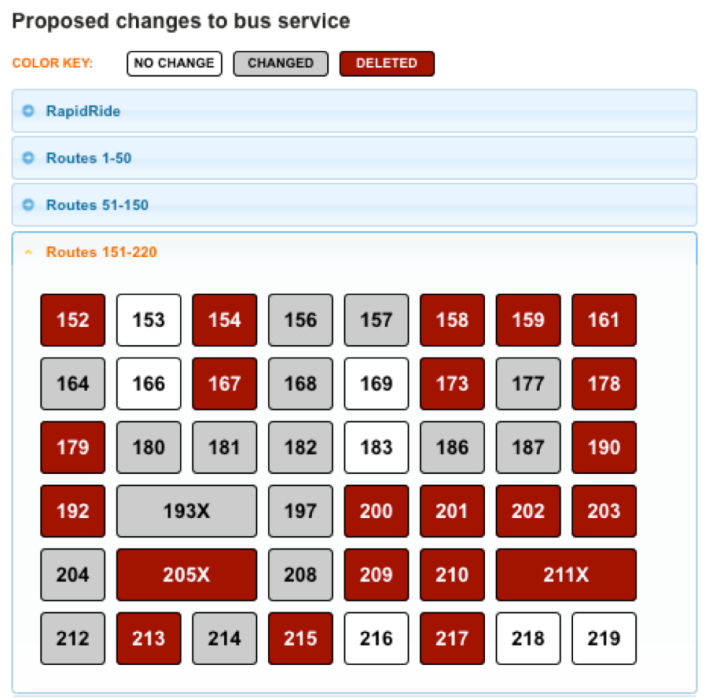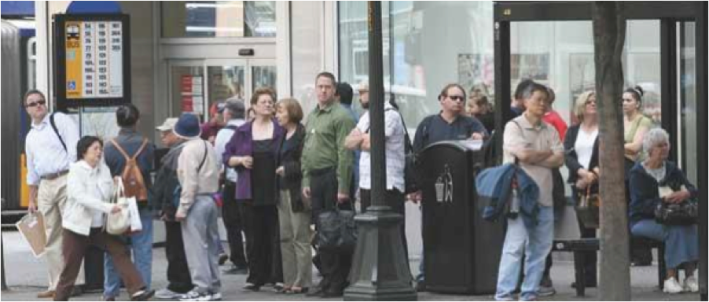If you’ve ever looked deep into the abyss of partisan gridlock and anti-tax paranoia and wondered where the bottom was -- well, Seattle might be approaching it right now. Facing a massive budget gap -- caused largely by the antagonism and negligence of state legislators -- Metro Transit has announced a plan to cut spending 17 percent by eliminating 74 bus routes.

Metro’s plan, unveiled yesterday, would "delete" 74 of the system’s 214 bus routes. And 107 routes -- fully half the current system -- will be "changed," mostly by reducing or eliminating nighttime service. Some buses will stop running as early as 7:00 p.m. The 33 “unchanged” routes will see changes too, Metro notes -- they will become more crowded.
"Riders and communities across King County would feel the impacts: fewer travel options, longer waits between buses, more transfers, more-crowded and less-reliable buses, and increased traffic congestion,” Metro writes on its website.
This happens at a time when record ridership is already stressing the system. “There’s not enough buses,” says Seattle’s “bus chick," Carla Saulter. "The buses are crowded. There’s not enough frequency. In every way, it’s just not meeting people’s needs." According to Metro’s service guidelines, the agency should be expanding service by 15 percent. Saulter, a car-free mother of two, says her primary bus route -- the 27 -- is facing elimination.
“We don’t want to be cutting service -- in fact, we should be growing here in King County,” Metro General Manager Kevin Desmond said in a videotaped message. “It would improve the quality of life and improve our economic future. But unless we find new revenue, we are looking, unfortunately, at having to reduce the system.”
That “unless” is key. Bruce Nourish, writing in the Seattle Transit Blog yesterday, noted that this “bloodbath” of cuts is avoidable.
There are two possibilities for forestalling this crisis. First, King County could form a countywide Transportation Benefit District and raise revenues that way. Seattle has its own TBD but since Metro Transit is run by King County, other parts of the county need to help fund it -- including rural and semi-rural areas where extending transit service is extremely expensive and not cost-effective. So far, the county has opted not to form its own TBD.
Second -- and more ideally -- the state legislature could grant local jurisdictions the authority to enact -- or at least, let voters decide on -- a motor vehicle excise tax, or MVET. The city had one before 1999, when anti-tax zealot Tim Eyman spearheaded a statewide ballot initiative that turned a 1.5 percent tax on the value of cars into a $30 flat fee per vehicle. (For the record, $30 is equivalent to 1.5 percent of the car value if your car is worth $2,000.)
In 2011, the Seattle City Council imposed a $20 registration fee within the city's transportation benefit district, which allows the city to enact these flat fees but not a MVET percentage tax. Later that year, Seattle asked voters to approve an additional $60 “car tab” fee, but the proposal lost. The post-mortem wisdom was that the tax was earmarked for such a wide range of projects no one really had a grip on what it would accomplish.
Saulter insists a more narrowly-defined tax to save Metro Transit from these onerous cuts would pass easily. Even better if it were a percentage instead of a regressive flat fee that’s still too low to solve the problem.
Will the state step in to save the day? Not likely. In an echo of the current federal paralysis on transportation funding, a major transportation spending package has been tied up at the state level for some time -- and with it, local taxation authority. The Democratic governor and House of Representatives are trying to move it, but the State Senate, narrowly controlled by Republicans and a handful of Democrats that caucus with them, has been holding it up.

Though some have suggested cutting costs by reducing overtime and renegotiating labor contracts, David Lawson of the Seattle Transit Blog -- who this morning posted an extremely comprehensive guide to the cuts -- disagrees. “I’m skeptical that further efficiencies could backfill a hole of this size,” Lawson said. “They’ve already implemented quite a few efficiency measures in the last few years.”
Perhaps the most frustrating aspect of this is that the controversial rebuilding of the Alaskan Way Viaduct, a highway through the middle of downtown, was supposed to be “mitigated” by setting aside funding for Metro. But that money won't be nearly enough.
“That money is running out in 2014, and to my knowledge, none of the transportation proposals on the table in the state legislature backfill it,” Lawson said. “And this is happening even though the tunnel itself is not going to be done till 2016, and the new route that will take buses from the entrance of the tunnel into downtown won't be done until 2018.”
Some mitigation effort.
Metro’s proposed cuts are at least considered by Lawson and other observers to be thoughtfully conceived. Despite the pain of the cuts, Lawson writes, Metro's planning staff deserves “a hearty round of applause" for issuing "the most ambitious restructure effort Metro has ever announced.” Some of the changes under this restructuring would be welcome even under flush times, he said.
Rather than doing across-the-board reductions, Metro planners are “proposing real restructures to eliminate duplicative service, maintain frequency, and reassign the remaining service to where the most riders are,” Lawson writes.
Of course, focusing on high-ridership routes means cutting what might be the one low-frequency bus route in low-ridership areas, leaving people there with zero transportation options.
All in all, “this change is heartbreaking to anyone who wants to see Seattle evolve into a place where car ownership is optional rather than mandatory for a significant number of residents,” Lawson writes.
If funding does not come through, the cuts are scheduled to take effect next September.





